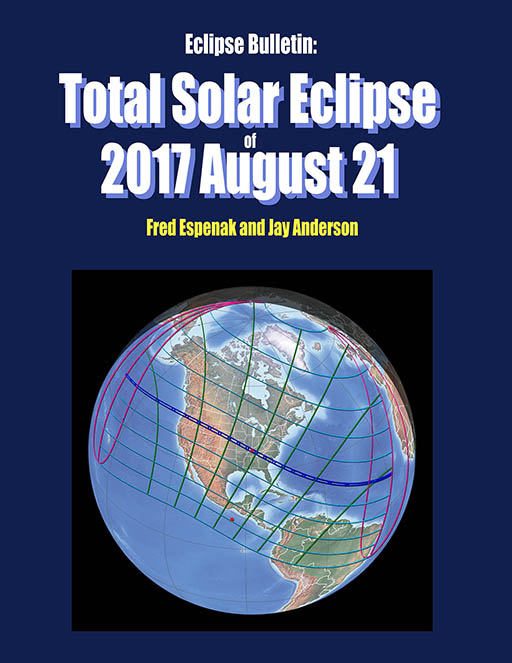Eclipse Bulletin: Total Solar Eclipse of 2017 August 21
By Fred Espenak and Jay Anderson

Publication: Eclipse Bulletin: Total Solar Eclipse of 2017 August 21
Author: Fred Espenak
Publication Date: 2015 May
Publication Size: 8.5 x 11 inches (21.6 x 27.9 cm)
Number of Pages: 156 (Black & White)
Price: $19.99
Order Here
Description
On Monday, 2017 August 21, a total eclipse of the Sun will be visible from the contiguous United States for the first time since 1979. The track of the Moon's umbral shadow begins in the Pacific Ocean and crosses the nation from west to east through Oregon, Idaho, Wyoming, Nebraska, Kansas, Missouri, Illinois, Kentucky, Tennessee, Georgia, North Carolina, and South Carolina. Inside the 70-mile-wide path of totality, the Moon will completely cover the Sun as the landscape is plunged into an eerie twilight, and the Sun's glorious corona is revealed for nearly 3 minutes. Outside the narrow shadow track, a partial eclipse will be visible from all of North America.
Eclipse Bulletin: Total Solar Eclipse of 2017 August 21 is the ultimate guide to this highly anticipated event. Written by two of the leading experts on eclipses, the bulletin is a treasure trove of facts on every conceivable aspect of the eclipse. The exact details about the path of the Moon's shadow can be found in a series of tables containing geographic coordinates, times, altitudes, and physical dimensions. A set of high resolution maps plot the total eclipse path across the USA. They show hundreds of cities and towns in the path, the location of major roads and highways, and the duration of totality with distance from the central line. (Click here to see a sample map)
Local circumstances tables for more than 1000 cities across the USA provide times of each phase of the eclipse along with the eclipse magnitude, duration and Sun's altitude. Additional tables cover the eclipse circumstances for cities in Canada, Mexico, Central and South America and Europe. (Click here to see a sample table of local circumstances). An exhaustive climatological study identifies areas along the eclipse path where the highest probability of favorable weather may be found. A travelogue highlights key locations in the eclipse track from Oregon through South Carolina. Finally, comprehensive information is presented about solar filters and how to safely observe and photograph the eclipse.
For 15 years, Fred Espenak and Jay Anderson published more than dozen eclipse bulletins through NASA, each one covering a major upcoming solar eclipse. Prepared in cooperation with the International Astronomical Union, the bulletins were internationally recognized as the most authoritative reference for each eclipse. The team has reunited to produce this new bulletin on the 2017 total eclipse through the USA. And now, for the first time, the bulletin is available in both black & white and color editions.
About the Authors
Click the following link to read a brief biography on the authors Fred Espenak and Jay Anderson.
- Table of Contents
- Page from Detailed Eclipse Maps
- Page from Local Circumstances Tables
Eclipse Bulletin: Total Solar Eclipse of 2017 August 21 - Sample pages

